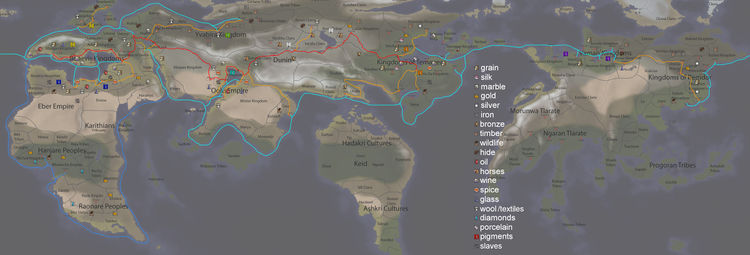Trade: Difference between revisions
No edit summary |
No edit summary |
||
| Line 1: | Line 1: | ||
[[File:riigatrade.jpg|750px|thumb|A map of major trade routes in among the connected Riigan cultures. Red: The Archroad. Orange: Archroad connections. Aqua: The main sea trading routes. Blue: The Diamond Route. Goods shown are only of major sources.]] | |||
Trade between major cultural groups in Riiga has been going on for centuries. The primary trading route by land is the Archroad. Major sea routes also exist, mostly connecting the Benevis Kingdoms, the Eber and Oolu Empires, and the Temanean, Vaman, and Remdor Kingdoms. | Trade between major cultural groups in Riiga has been going on for centuries. The primary trading route by land is the Archroad. Major sea routes also exist, mostly connecting the Benevis Kingdoms, the Eber and Oolu Empires, and the Temanean, Vaman, and Remdor Kingdoms. | ||
Revision as of 10:17, 8 December 2019
Trade between major cultural groups in Riiga has been going on for centuries. The primary trading route by land is the Archroad. Major sea routes also exist, mostly connecting the Benevis Kingdoms, the Eber and Oolu Empires, and the Temanean, Vaman, and Remdor Kingdoms.
History of the Archroad
The largest land-based trade route (shown in red) has its roots as far back as 150BD, when the Xilou Hoqomer expanded all throughout what is now Benevis, and went as far east as the Sea of Lions in Sheber. Back then, any trade possibilities further east were cut off by the Baturun people of Batur, who were very defensive of their land at that time.
It wasn't until about 200AL, when the Dunian Empire stretched from eastern Yyele to western Batur, that significant trade was possible between the east and west. The Baturians of this new empire had the best horses in the world at the time, and this allowed them to easily transport goods that were once only available to those around the Gold Sea as far away as the Oolu Empire. Goods made their way from Oolu into the East Xilou Hoqomer, the West Xilou Hoqomer, and finally into both the Qeyu Hoqomer and to the Vastions of Nor. Over the following centuries, this trade route influenced the politics and economies of all people along its path.
Oolu Empire's Free Trade
The Oolu Empire, being a central component of the Archroad, has adopted free trade. Given that they lack many important resources and luxuries compared with people further east and west, both national and privatised trade companies exist, ensuring that the road stays passing through the Oolu Empire, rather than going north of the Khatsanaras through Yvabira. Utilising this position in the early days of the road's growth has allowed the Oolu Empire to increase growing, despite most its land being some of the poorest among other major kingdoms and empires overall.
The Diamond Route
Recent advances in shipbuilding technology have allowed the Benevis Kingdoms to travel further than ever before. Since around 600AL, these people have established a trade route that goes by sea around the southern end of Baracsa. The first people from Benevis to make these trade routes met the Hanjare and Raonare people, especially those of what are now the Shcholi Kingdom, the Mbokecho Empire, the Hade Empire, and the Efisi States. It was discovered that though these people were less technologically advanced overall, the people knew how to obtain large amounts of high quality diamond and gold from their lands. Henceforce the Diamond Route was made.
The route itself is a lengthy, dangrous route for ships to take. Travelling down the western coast of Baracsa will see sailors travelling for extended periods without any signs of civilisation. Once reaching the kingdoms and empires in Nzandyi Bay, the trip becomes no less safer, as local pirates are extremely common, taking advantage of all the merchants looking to obtain cheap gold and diamond. Travelling up the eastern coast of Baracsa is no easier, as storms frequent the scarcely-populated lengths of coastline. Reaching the Mvecho Island kingdom is considered to be the end of the dangerous route; from here ships can join the sea routes that go from the Vastin Kingdom to the Oolu Empire without too many complications.
Goods Traded Globally
The major cities along the trade route, from west to east: Lyte, Valarvis, Alfar, Cangona, Regalias, Costarson, Goldstone, Hillcrest, and Duracia in Benevis; Ellecil in Huirnon, Aswaun in Masakana; Dhrewar and Sakhratja in the Oolu Empire; Yqozldatt, Osmangiyq, and Mancisa in Dunin; and Tetamak, Selangin, Ruipin, Lema Da, and finally Ho Da in the Kingdoms of Temanea.
Along the Archroad, The Benevis Kingdoms mostly offer wine, hide, oil, wool, marble, and grain. Minor goods include gold, spice, and pigments, mostly from the southeastern corner.
The Eber Empire offers pigment, wildlife, spice, glass, oil, and grain, though it does not trade in quantities comparable to the Benevis Kingdoms.
The Oolu Empire offers high quality glass and spices, as well as some marble, grain, and oil.
The Dunin people mainly offer high quality horses and wool, as well as some bronze and hide.
The Temanean Kingdoms primarily offer silk, porcelain, and grain. Minor goods include pigment, spice, silver, gold, and bronze.
Other people who trade with the Archroad indirectly include those in and around the Yvabira Kingdom, offering a lot of iron and lumber, as well as some wool and hide, and the Hanjare and Raonare Kingdoms, offering high quality gold and diamonds, as well as wildlife.
The Suribian trade road sees iron, grain, glass, and hide from Vaman exchanged with lumber, silver, and gold from the Remdor Kingdoms. These goods are also occasionally traded overseas via the route to the Gold Sea to the west, or the Sea of Lyte to the east. The Tlarates of southwestern Suribia such as Morunwa and Ngara are thought to be the only major cultural group within Riiga which does not trade with outside cultures.
